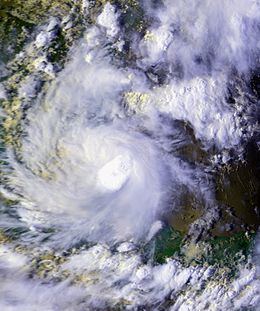Formed August 31, 1988 Fatalities 20 direct Highest winds 121 km/h | Dissipated September 8, 1988 Areas affected Mexico Affected area Mexico | |
 | ||
Lowest pressure 987 mbar (hPa); 29.15 inHg Date 31 August 1988 – 8 September 1988 Similar Tropical Storm Chris, Hurricane Florence (1988), Tropical Storm Beryl, Tropical Storm Keith, 1949 Texas hurricane | ||
Hurricane Debby was the strongest tropical cyclone to strike the Gulf Coast of Mexico since Hurricane Barry in 1983. The eighth tropical depression, fourth tropical storm, and the first hurricane of the 1988 Atlantic hurricane season, Debby developed from a tropical wave off the west coast of the Yucatan Peninsula on August 31. The system slowly intensified as it tracked west-northwestward toward Mexico, eventually reaching tropical storm status on September 2. Thereafter, Debby began to rapidly strengthen, and the storm was upgraded to a hurricane later that day.
Contents
After intensifying into a hurricane, Debby made landfall near Tuxpan, Veracruz, Mexico. Debby quickly weakened inland, however, the storm managed to remain intact over Mexico. After crossing into the eastern Pacific from Mexico, Debby became Tropical Depression Seventeen-E, which moved northwest, but sheared and later dissipated.
300,000 people evacuated from Mexico as Debby caused mudslides and heavy rains throughout much of the country. Debby ended up causing at least 20 fatalities, all directly related. The total damage for Mexico was not released.
Meteorological history
A strong tropical wave formed off of Africa's northwest coast on the August 15. As the wave moved westward a split area of the wave became Tropical Depression Seven near the Lesser Antilles. That system moved westward and became Tropical Storm Chris days later. The leftover wave continued westward and entered the Caribbean Sea as a disorganized center of showers. During the night of August 29, some convection came together and a low-level center appeared over the Yucatán Peninsula. The center moved into the Bay of Campeche and was declared a 1.5 on the Dvorak Scale and was forecasted to become Tropical Depression Eight at that time, 1800 UTC August 30.
Banding came together and outflow patterns organized on September 1. Tropical Depression Eight moved westward and development increased, becoming Tropical Storm Debby on September 2. Debby moved towards Tuxpan, Mexico at 7 mph (11 km/h) while an Air Force weather reconnaissance aircraft found winds of 90 mph (140 km/h) at 1,500 ft (460 m) levels and 80 mph (130 km/h) at the surface of the storm, upgrading Debby into the first hurricane of the season on September 2. At that point, Debby's small center was only 35 mi (56 km) from Mexico. No more reconnaissance aircraft were deployed prior to landfall and forecasters depended on satellite imagery, which called little change in strength. Debby made landfall in Tuxpan, Mexico on September 3 at 0000 UTC. Debby weakened over Mexico's mountainous terrain, but was able to keep its bonding to become Tropical Depression Seventeen-E in the Eastern Pacific basin.
As Hurricane Debby entered the Eastern Pacific, it became Tropical Depression Seventeen-E on September 5. Little movement occurred, leaving it stationary off the coast of Manazillo. Even though Tropical Depression Seventeen-E was a poorly organized cyclone, the possibility that it could still become a tropical storm in the small and narrow Gulf of California was possible. Six hours after that forecast, wind shear appeared and with the close proximity to land, the forecast changed to staying as a depression.
At this point, Tropical Depression Seventeen-E was under the influence of a low-level trough and weak steering currents. A new low level center appeared on September 7, causing locally heavy rains and producing a new chance for Tropical Depression Seventeen-E to develop into a storm. Also at this point, Tropical Depression Seventeen-E was difficult to track through satellite imagery. Tropical Depression Seventeen-E came close to land, so the prediction to become a storm was doubtful and landfall was expected within 48 hours. Wind shear caused Tropical Depression to dissipate on September 8 near La Paz.
Preparations and Impact
Multiple warnings and/or watches were released in accordance with Hurricane Debby. The first was a tropical storm warning for Santa Cruz to Veracruz on September 2. Part of it was discontinued the same day from Santa Cruz to Punto Jerez. The rest was discontinued a few hours later. The Punto Jerez to Veracruz area was put under a hurricane warning on September 2 and was discontinued that night. Tropical storm and hurricane warnings were put in place, but were soon discontinued. Strike probabilities for land were low, however, Brownsville, Texas got a five percent chance of Debby passing within 65 mi (105 km) of it. Over 30,000 people were evacuated, many in Veracruz.
Reports for Tuxpan, Mexico were non-existent and all that is known there is that locally heavy flooding occurred. Only 20 deaths were reported to be caused by Debby. Three were caused by a landslide in Papalanta that crushed two homes. Three storm-related deaths were reported with house-crushing landslides in Poza Rica. Four people died and sixteen were injured in a town north of Mexico City when a mudslide crushed some homes. In Veracruz, ten other people were killed as emergency crews rushed to find shelter for 25,000 - 50,000 more that were displaced. Debby caused power outages in Tuxpan, Poza Rica and several other places. In Poza Rica, debris caused water runoffs to be blocked. Mud and rocks blocked roads and dozens were rescued from house and car flooding. Eight communities sustained a major portion of damage.
